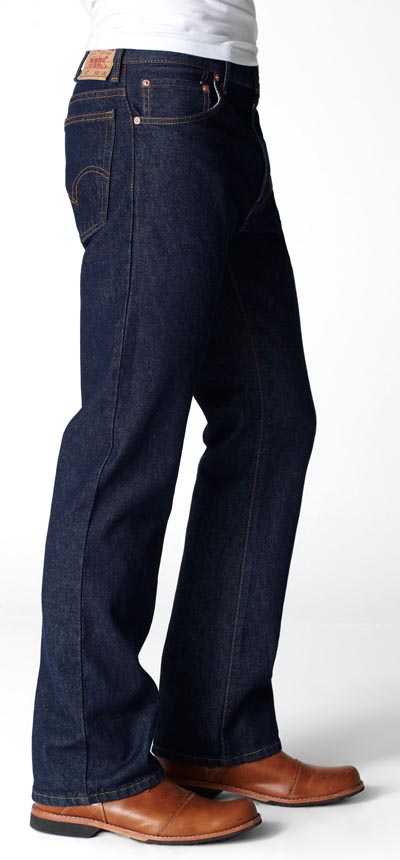Any of those words is a clue that you’re talking about the legs of the trousers, not the seat, drop, or waist. “Taper” jeans are also sometimes called “skinny” — not to be confused with “slim fit,” which we just discussed above!
Complicated, right? But in basic terms, these describe how the width of the trouser legs change over time:
- Taper or skinny jeans do just what the name says: they taper from the opening at the thigh to the opening at the cuff. Ankle openings in the 14″-16″ range generally get called “skinny” jeans, unless they’re paired with unusually small waist/seat sizes.
- Straight or regular legs are roughly the same size from the thigh to the ankle. They’re basically a tube of fabric (well, two tubes of fabric, joined together). It’s the most classic look for jeans, largely because it was the easiest to make when people were doing everything by hand.
- Boot-cut or wide-leg jeans are, as the name implies, designed to be worn over boots. The assumption is that several inches near the bottom will be resting against a boot, rather than against naked ankle/calf. They’re made several inches wider at the bottom than the top. Worn with low shoes or sandals, they look dangerously close to “flares,” which is not a style any man should aspire to.
The shape of your body and the shoes you like to wear affects the kind of leg you want. Men with a lot of taper to their legs — like the “footballer” build we discussed above — may want a relaxed fit in the seat but a skinny leg, to fit the taper of their legs. Bulkier men with thick ankles and thighs will feel more comfortable in a regular seat and straight legs. And workmen who wear boots, obviously, will want wide-leg jeans to accommodate them.
Other Terms
Most jeans will be described by a combination of one “fit” term (slim/regular/relaxed or something similar) and one “leg” term (skinny/straight/boot-cut or similar).
From time to time, however, you get outliers. Most are just marketing words with limited actual meaning, or else are synonyms for the existing fit/leg terminology. Here are a few we’ve seen and what they usually mean:
- High-rise refers to jeans with an extra-long rise. These are designed to sit high on the waist (which may mean a smaller waist size than you’re used to buying, if you’d previously been wearing jeans nearer to your hips). A lot of relaxed-fit jeans are already high-rise, or close to it, but anything with the phrase in the description is going to be particularly long in the rise. They’re comfortable, and can help conceal weight around the belly, but they’re considered fairly unstylish.
- Low-rise are the obvious opposite to high-rise jeans, and are generally reserved for women’s jeans. Some brands make skinny and regular fit that sit pretty low on the hips, but they aren’t usually marketed as low-rise. Anything that is marketed as low-rise is going to have some pretty noticeable sag — usually more than you want unless you’re a rapper.
- Loose sometimes gets used interchangeably with “relaxed,” but in some brands it refers instead to a bowed waistband that hangs lower on the body than a straight one. You don’t run into them too often, but if you’re buying anything called “loose” jeans, make sure you like the fit in the waist.


No comments:
Post a Comment